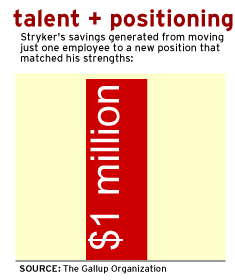A team of mechanical engineers working with complex surgical equipment would require a set of special abilities, right?
That's undoubtedly true. But even within such a team, it is crucial to position members in highly individualized roles according to what they do best. And doing so can translate into huge efficiency gains, not to mention happier employees.
 |
Just ask Rich DeVault, a manager in Advanced Manufacturing Engineering at Stryker Instruments. Concerned that one of his employees wasn't being given the opportunity to use a key talent, DeVault shifted him from a position in new product development, where he was primarily an individual contributor, to one in technical supervision, where he worked with numerous subcontractors to improve the state of electronics production. The employee ended up saving the surgical equipment maker $1 million in electronic component sourcing.
Furthermore, DeVault notes, "The look on his face when he's working is different -- he's much more absorbed in what he's doing. His new position allows him to use his Arranger talents by coordinating a number of in-house and subcontractor resources. His enthusiasm stepped up as well as his impact."
Two years ago, after completing Gallup's Great Manager Program, DeVault and a fellow manager had everyone in their department take Gallup's StrengthsFinder assessment. They then put together a composite picture of the department's most common Signature Themes. A few stuck out, and DeVault sees them as key to the group's success. They included:
- Responsibility -- The level of psychological ownership this theme implies promotes the accuracy and detail orientation needed to develop precision tools used to save lives.
- Learner -- Their natural attraction to the learning process helps employees keep up with developments in the rapidly changing field of medical technology.
- Achiever -- Related to the need to keep up with medical developments is the need to contribute to them. Stryker Instruments' mission to build tools that continually improve surgical techniques and reduce surgical time and trauma is extremely demanding; its fulfillment requires the high level of motivation implied by the Achiever theme.
DeVault is always considering whether his employees have opportunities to develop and use strengths to the company's advantage. He uses Gallup's Q12 employee engagement measure to track the results, keeping a close eye on responses to the question that asks team members if they have the opportunity to do what they do best every day (See "Doing What I Do Best" in See Also).
One senior engineer came closer to that goal when DeVault helped him eliminate most of the paperwork from his job. "He just got bogged down in it," DeVault says, "so we eliminated that part of his job by redistributing it among team members who could more comfortably balance it with their engineering contributions."
Such opportunities don't always present themselves. The ideal goal of having everyone working happily in areas of natural inclination 100% of the time is unrealistic. For most people, there will always be aspects of the job about which they feel less passionate or enthusiastic. But as DeVault will attest, simply having managers who are aware of their employees' talents can bring a workplace closer to that ideal, with positive implications for productivity.
"People are just going to do more when they work in an area of strength," DeVault concludes. "They almost involuntarily take more on because it makes them feel more effective."